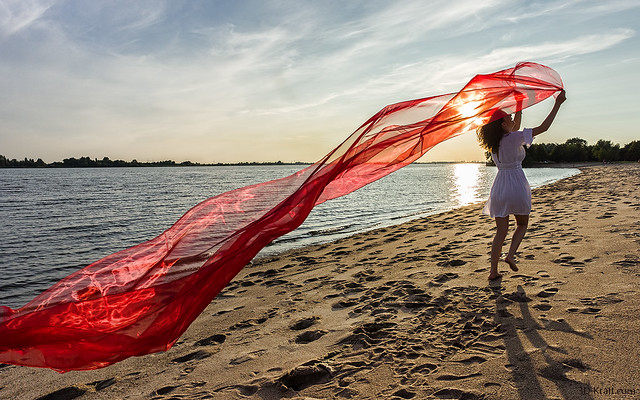July 2013 - If you are looking for an ultra wide angle lens for Sony NEX APS-C sensors based cameras, meanwhile you have an "embarras de richesses" between the new Zeiss Touit Distagon T* 12mm f/2.8 and the Sony 10-18mm F4 OSS zoom lenses. This article will provide you an in-depth comparison between these two lenses.
Before we go into details, let's take a look at the lenses themselves:
Both lenses are surprisingly lightweight and compact. The Sony wide angel zoom weighs about 260g, the Zeiss prime about 300g including lenshood and caps. If you compare that to a full frame ultra wide angle like the Zeiss Distagon T* 15mm f/2.8 (730g) or the Nikon 14-24mm f/2.8 zoom (about 1kg), these lenses will burden you (and your wallet) significantly less than their full frame equivalents for the price of about one F-stop less low light performance and DOF options than a comparable fullframe combination.
Before comparing sharpness and bokeh, let me just give you some more examples taken with the Zeiss Touit 2.8/12. that show you typical application areas and compositions for such a kind of lens:
Action with thrilling viewing angle:
Architecture:
Food - close up. playing with depth of field (DOF) @ f/2.8:
Fireworks with lots of surrounding:
(Click on images for other sizes)
Sharpness comparison
When using an ultra wide angle lens, getting sharp architecture shots across the whole frame may be one of your primary goals. So let us compare it with a typical example (lens correction profiles in Adobe Lightroom / ACR applied).
Zeiss Touit 2.8/12 @ F5.6 (overview):
Sony 10-18mm f/4.0 OSS @ 12mm @ F5.6 (overview):
If we take a look at 100% actual pixels in the center...


...the differences in sharpness and contrast are negligible and perhaps more a matter of focus precision. But if you take a closer look at the borders (in this example the left border), there is a visible advantage for the Zeiss Touit:
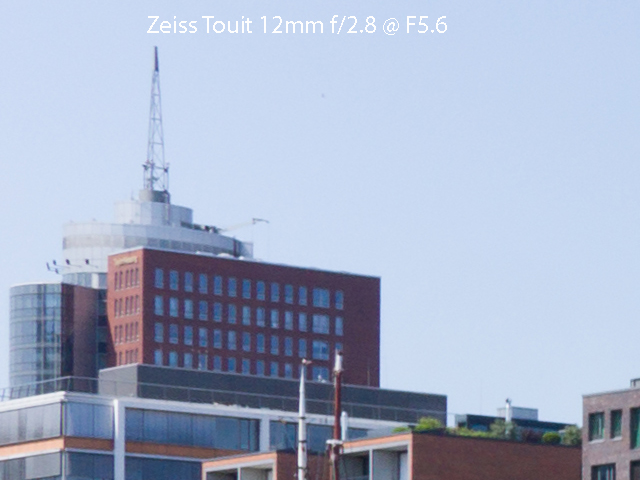

Distortion, edgesharpness/field curvature
If you ever shot a lens with such a wide viewing angle, you propably know about the difficulty to find a target at typical shooting distance that is appropriate to evaluate distortion, edge sharpness and field curvature. The following series of images at different apertures (developed from RAW without lens correction profile) will give you an indication about the distortion of the lenses and the impact of field curvature when shooting a planar target:
Zeiss Touit 2.8/12 @ F2.8, F4.0, F5.6 and F8.0:
(Click images for other sizes)
Sony 10-18mm F4 OSS @ 12mm @ F4.0, F5.6 and F8.0:
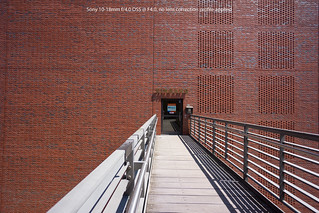
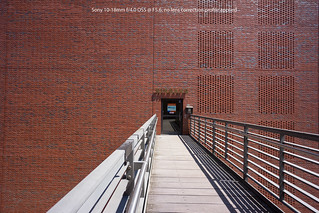

(Click images for other sizes)
If you find it too boring to scroll through these images by yourself at 100% size (which I certainly understand), simply let me list my findings:
- The Zeiss Touit 2.8/12 is already very sharp and rich in contrast at open aperture (F2.8) but at this aperture the edges are a bit too blurry already. This is caused by field curvature and you can get the edges sharp by moving the focus but only for the price of decreasing center sharpness
- Distortion and vignetting is quite good controlled on both lenses, it needs only little correction
- At F5.6 and F8.0, when the impact of field curvature becomes less important due to larger depth of field, the Zeiss performs a little bit better in the edges
Bokeh?
Of course the primary intention of a super/ultra wide angle lens on a crop sensor is not really to let you play with shallow depth of field and overwhelm you with blurry backgrounds and creamy bokeh but at least for close ups (food, flowers), it may open some nice options and perspectives. So let us compare:
Zeiss Touit 2.8/12 @ F4.0:
...and the Sony 10-18mm F4 OSS @ 12mm @ F4.0:
At F4.0 the bokeh and background blur of the Sony is a little bit softer but the Zeiss has the potential to add up a shovel and provide some more "3D pop":
Zeiss Touit 2.8/12 @ F2.8:
Back light
Some people asked me about the behaviour of these lenses when pictures are taken against the light - voilà:
Zeiss Touit 2.8/12 @ F22:
Sony 10-18mm F4 OSS @ 12mm @ F22:
Both lenses are capable to create nice backlight effects (stars etc.), the Sony may show some minor flares in particular situations.
Low light performance
One of the questions that frequently drive controversal discussions is whether (and in which degree) optical stabilization can compensate less light transmission due to smaller apertures in low light situations. As this can not simply be measured, the only way to get an estimation is by shooting large amounts of pictures and interpret the results statistically.
The following example shows the high altar in Erfurt's legendary cathedral. There is not much light passing through the colored windows and you are not allowed to use a flash or tripod - quite typical situation for many other churches as well so you have to shoot free-hand at available light.
With the Sony I took 12 exposures between 1/4s and 1/8s (ISO 400 and ISO 800), half of them were sharp enough also for larger prints. Four of five of the exposures taken at 1/4s were good so the OSS seems to work quite effective in this range.
With the Zeiss I took 11 exposures between 1/8s and 1/20s (ISO 400 and ISO 800) from which 6 were good in total but none of those taken with ISO 400. So I decided to show the best results at these different ISO settings:
Zeiss Touit 12mm @ f/2.8 @ 1/15s / ISO 800:
Best result with the Sony 10-18mm F4 OSS @ 12mm @ F4 @ 1/4s / ISO 400:
...and the corresponding 100% crops (actual pixels):

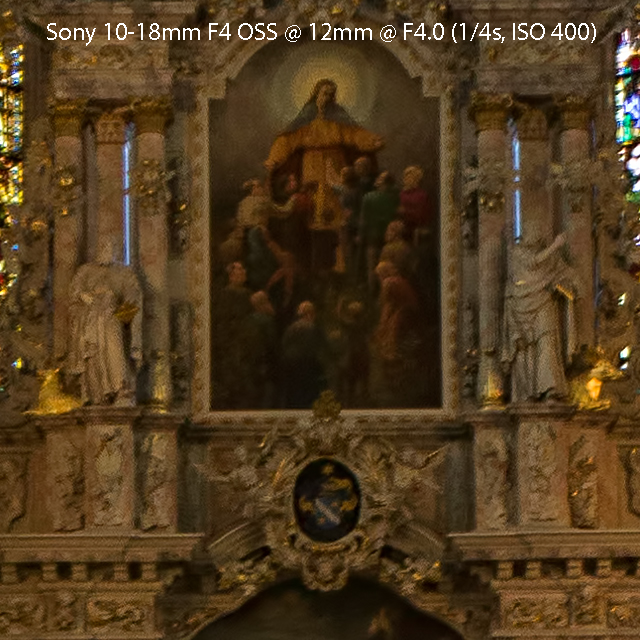
In order to expand the examination I compared the results in another situation with even less light:
Zeiss Touit 2.8/12 @ F2.8, 1/13s, ISO 800
Sony 10-18mm F4 OSS @ 12mm, F4.0, 1/8s, ISO 800:
(Click images to open other sizes)
Similar statistics in this situation: Two of twelve shots taken with the Sony were sharp, two of 13 exposures taken with the Zeiss were good and one was fair but all shots taken with the Zeiss were not as sharp as the two hits of the Sony.
So overall I would say that the OSS of the Sony compensates a bit more than the one f-stop that the Zeiss opens wider.
The Verdict
- The Zeiss Touit satisfys me a bit more when shooting landscapes/architecture stopped down to F5.6 or F8 due to slightly sharper borders and edges (when the impact of field curvature becomes negligible). Both are nearly free from CA.
- The additonal f-stop of the Zeiss allows to play a little bit more with sharpness / background blur (bokeh) in close up situations.
- Under extreme low light conditions, the Sony OSS compensates a bit more than the one additional f-stop of the Zeiss. Even at 1/4s chances are still quite good to get sharp images whereas the chance to get a sufficiently sharp image with the Zeiss 2.8/12 decreases significantly when shooting with exposure times longer than 1/15s.
- The Sony is the more flexible lens especially when you are travelling due to its zoom range.
Both lenses can give you amazing results at a fraction of weight, size and budget that you would have to carry with an equivalent full frame combination. It was also surprising for me how close the Sony zoom gets optically to the Zeiss prime lens.




